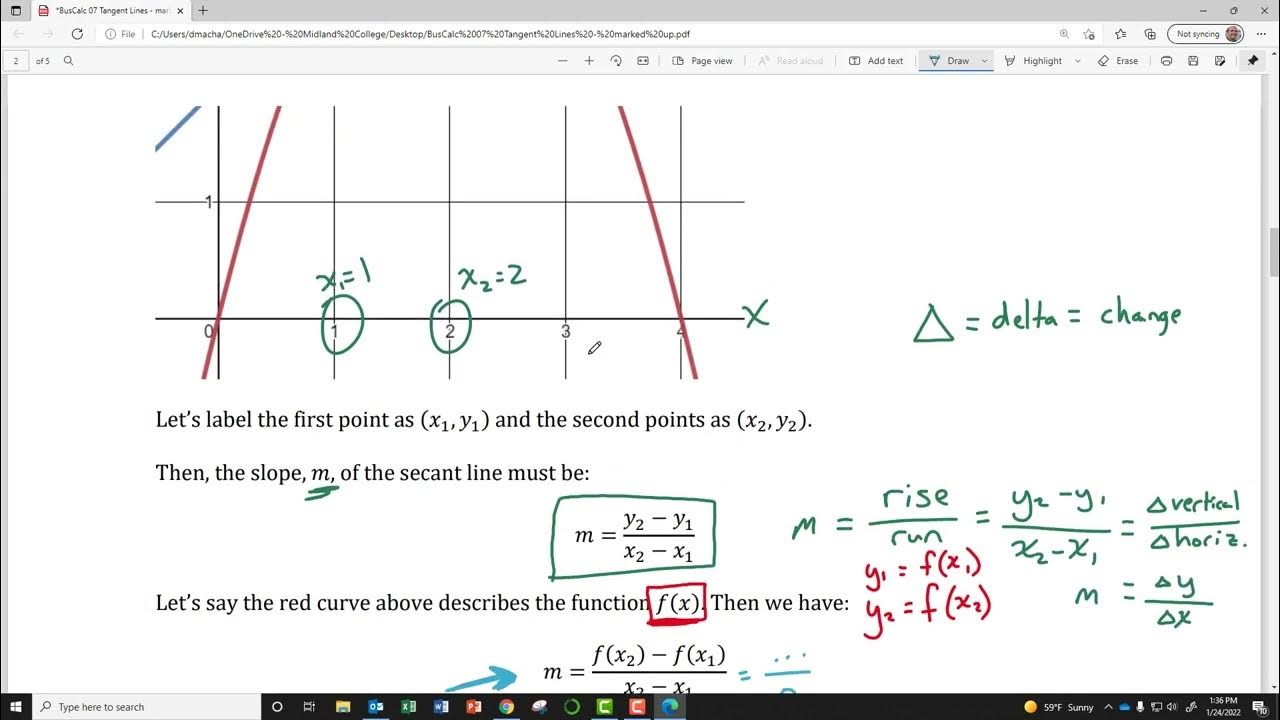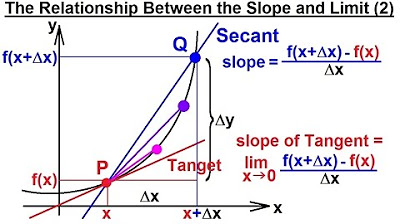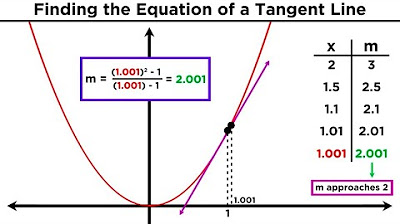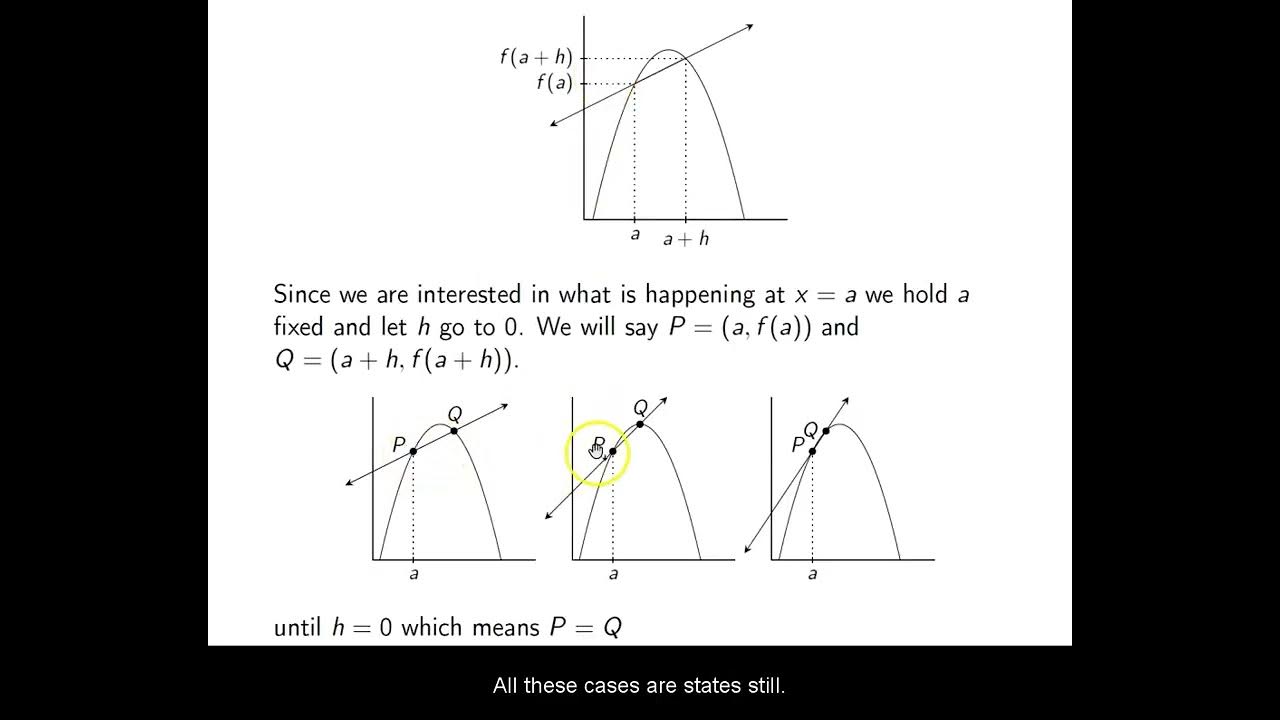The Tangent Line and the Derivative (Calculus)
TLDRThe video script delves into the concept of tangent lines, which have been studied for over 2,000 years. Initially defined as lines touching a circle at a single point, the definition has evolved to include other curves such as parabolas and ellipses. The modern definition involves a line that touches a curve at precisely one point without crossing it, and this is further clarified using calculus and the concept of limits. The video also explores the relationship between tangent lines and derivatives, illustrating how the slope of the tangent line at a point is equivalent to the derivative at that point. The process of finding the equation of a tangent line is demonstrated using an example of a parabola, emphasizing the importance of understanding both the geometric and algebraic aspects of calculus.
Takeaways
- 📐 The original definition of a tangent line was a line that touched a circle at exactly one point.
- 🔍 The modern definition of a tangent line has expanded to include touching other curves, not just circles.
- ❌ A common misconception is that a tangent line touches a curve at only one point, but this alone does not define a tangent line.
- 🔄 A more accurate definition is that a tangent line touches a curve at one point without crossing it and cannot be rotated to intersect the curve at another point.
- 📉 The concept of limits is used in calculus to define a tangent line as the line that represents the behavior of a curve at a given point as another point approaches that location.
- 🚫 A tangent line must touch the curve; if it does not, as in the case of the graph of sin(x)/x at (0,1), there is no tangent line at that point.
- ↔️ The limit of the secant lines as they approach a point from both the left and right must be the same to define a tangent line.
- 📈 The derivative of a function at a point is the slope of the tangent line to the graph of the function at that point.
- 📈 The slope of the tangent line can be found by calculating the limit of the slopes of secant lines as the points defining the secant lines approach the point of tangency.
- 🔢 Differentials (dx and dy) are used in calculus to represent infinitesimals, which are useful for finding derivatives and slopes of tangent lines.
- 💡 The equation of a tangent line can be found using a point on the curve and the derivative at that point, which gives the slope of the tangent line.
Q & A
What is the original definition of a tangent line?
-The original definition of a tangent line was a line that touched a circle at just one point.
How has the definition of a tangent line evolved over time?
-Over the centuries, the definition of a tangent line has been expanded to include lines touching other curves, not just circles, such as parabolas, ellipses, and more elaborate curves like the sine curve.
What is a common misconception about the definition of a tangent line?
-A common misconception is that a tangent line to a curve is simply a line that touches the curve at only one point. However, this definition is incomplete as it does not account for how the line approaches the curve.
What is a more precise definition of a tangent line?
-A tangent line to a curve is a line that up close just touches the curve at only one point in a way that if you rotate the line even slightly, it will become a secant line across the curve at a second nearby point.
How is the concept of limits used in calculus to define a tangent line?
-In calculus, the tangent line to a point is defined as the limit of the secant lines as a nearby point approaches the given point. The tangent line must touch the curve at the point, and the limit of the secant line should be the same regardless of whether you approach from the left or the right.
What is the connection between a tangent line and the derivative of a function?
-The derivative of a function at a point is the slope of the tangent line at that point. It measures the steepness of the curve at that point and is computed using limits, similar to how the tangent line is defined.
What are the two key conditions for a line to be considered a tangent line?
-The two key conditions are: first, the tangent line must touch the curve at the given point, and second, the limit of the secant line as a nearby point approaches the given point should be the same from both directions.
How can you find the equation of a tangent line using the derivative?
-Once you know the derivative (the slope of the tangent line), you can find the equation of the tangent line by using the point-slope form of a line, which requires one point on the line and its slope.
Why is it important that the limit of the secant lines does not depend on the direction of approach?
-It is important because if the left-hand and right-hand limits are different, it means the limit does not exist, and thus there is no unique tangent line at that point. This ensures that the tangent line is well-defined at the given point.
What is another way to think about tangent lines visually?
-Another way to think about tangent lines visually is that as you zoom in on a point on a curve, the curve and the tangent line become indistinguishable from one another, indicating that the tangent line is the line most similar to the curve at that point.
What is the significance of the point-slope form for a line in finding the equation of a tangent line?
-The point-slope form for a line (y - y1 = m(x - x1)) is significant because it allows us to express the equation of a tangent line using a point on the line and its slope, which is the derivative at that point.
Why is it not possible to have a tangent line at the point (0,1) on the graph of f(x) = sin(x)/x?
-It is not possible because the point (0,1) is not on the graph since plugging in x = 0 into f(x) results in division by zero, which is undefined. Therefore, the curve does not have a tangent line at that point.
Outlines
📐 Understanding the Definition of a Tangent Line
This paragraph explores the concept of tangent lines, which have been studied for over 2,000 years. Initially, a tangent line was defined as a line touching a circle at a single point. However, the definition has evolved to include lines touching other curves, such as parabolas, ellipses, and sine curves. The modern definition of a tangent line is nuanced and requires careful consideration of how the line approaches and touches the curve. The paragraph challenges the audience to define a tangent line by showing various examples, including correct and incorrect cases. It emphasizes that a tangent line must touch the curve at exactly one point without crossing it and that a slight rotation of the line should not create a second intersection with the curve. The use of calculus and limits provides a precise definition, where a tangent line is the limit of secant lines as a nearby point approaches the point of tangency.
🔍 The Importance of Limits in Defining Tangent Lines
This paragraph delves into the mathematical definition of a tangent line using limits. It states that a tangent line to a curve at point 'a' is the limit of the secant lines as a nearby point 'p' approaches 'a'. Two key aspects are highlighted: the tangent line must touch the curve at point 'a', and the limit of the secant line should be the same regardless of the direction from which 'p' approaches 'a'. The paragraph provides examples to illustrate the importance of these criteria, including a function where the tangent line does not exist because the point is not on the curve, and another where different secant lines are obtained depending on the direction of approach, indicating that the limit does not exist and thus no tangent line can be defined. The concept of the tangent line being the most similar line to the curve at point 'a' is introduced as a visual way to understand tangent lines. The relationship between tangent lines and derivatives is also discussed, with the derivative being the slope of the tangent line, which is computed using limits and can be used to find the equation of the tangent line.
🧮 Calculating the Equation of a Tangent Line
In this paragraph, the process of finding the equation of a tangent line is demonstrated using the example of the parabola y = x^2 at the point (3,9). The method involves selecting a nearby point 'p' with an x-coordinate 'h', which leads to a y-coordinate of 'h^2'. The slope of the secant line through the points (3,9) and (h,h^2) is calculated, simplified, and then the limit is taken as 'h' approaches 3. This results in a slope of 6 for the tangent line at the point (3,9). Using the point-slope form of a line, the equation of the tangent line is derived and then rearranged into the more common slope-intercept form y = mx + b, yielding the equation y = 6x - 9. Additionally, the paragraph humorously addresses the goal of Socratica to reach 7 billion subscribers and playfully requests the audience to encourage non-subscribers to join.
Mindmap
Keywords
💡Tangent Line
💡Secant Line
💡Limit
💡Derivative
💡Sine Curve
💡Parabola
💡Ellipse
💡Cubic Curve
💡Absolute Value Function
💡Differentiation
💡Differentials
Highlights
Tangent lines have been studied for over 2,000 years and originally referred to a line touching a circle at just one point.
The definition of a tangent line has expanded to include lines touching other curves, not just circles.
A common misconception is that a tangent line touches a curve at only one point, but this definition is incorrect.
A more accurate definition is that a tangent line touches a curve at a single point without crossing it.
The tangent line is the limit of the secant lines as a nearby point approaches the point of tangency.
The tangent line must touch the curve at a point and the limit of the secant line should be the same from both directions.
Using calculus, the tangent line can be defined as the limit of secant lines as a point approaches another, ensuring the slope is consistent from both directions.
The derivative of a function at a point is the slope of the tangent line at that point, representing the steepness of the curve.
The slope of a secant line is calculated using the change in y over the change in x, symbolized by delta (Δ).
Differentials (dx and dy) are used in calculus to represent infinitesimally small changes in x and y, respectively.
The equation of a tangent line can be found using a point on the line and its slope, which is the derivative at that point.
An example is given to find the equation of the tangent line to the parabola y = x^2 at the point (3,9).
The process involves finding the slope of the secant line as a nearby point approaches the point of tangency and then using the point-slope form to find the equation of the tangent line.
The final equation of the tangent line to the point (3,9) on the parabola y = x^2 is y = 6x - 9.
The importance of ensuring that the left-hand and right-hand limits are the same when defining a tangent line is emphasized to avoid ambiguity.
The tangent line is described as the line most similar to the curve at the point of tangency when visually zooming in on the curve.
The connection between tangent lines and derivatives is explored, with the derivative being the slope of the tangent line at a given point.
An appeal is made to the audience to help reach the goal of 7 billion subscribers by encouraging others to subscribe to Socratica.
Transcripts
Browse More Related Video

BusCalc 07 Tangent Lines

Calculus 1: Limits & Derivatives (4 of 27) The Relationship Between the Slope and the Limit (2)

1.4 - Differentiation Using Limits of Difference Quotients

Understanding Differentiation Part 1: The Slope of a Tangent Line

Definition of the Derivative | Part I

Ch. 13.3 Tangent Lines and Derivatives
5.0 / 5 (0 votes)
Thanks for rating: